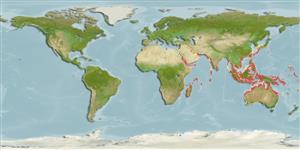Bivalvia |
Pectinida |
Pectinidae
Environment: milieu / climate zone / djupintervall / distribution range
Ekologi
; djupintervall 0 - 25 m (Ref. 348). Tropical
Indo-West Pacific: from East Africa, to the Philippines; north to southern Japan and south to the Malay Peninsula.
Length at first maturity / Size / Weight / Age
Könsmognad: Lm ? range ? - ? cm Max length : 6.0 cm SHL hane/ej könsbestämd; (Ref. 348); common length : 5.0 cm hane/ej könsbestämd; (Ref. 348)
Shell solid, small, nearly as long as high, inequivalve, the outline somewhat elongate dorsally and subcircular ventrally. Both valves convex, the right (lower) valve more inflated than the left (upper) valve which is moderately flattened towards the umbo. Ears small, subequal in size and shape. Right anterior ear with an obsolete anteroventral byssal notch, devoid of ctenolium. Outer sculpture of each valve with about 9 to 11 rounded radial folds, with numerous, much smaller secondary radial riblets that are finely lamellous on ribs or interspaces; transverse lamellous sculpture delicate and easily eroded on top of ribs. Hinge line short, about 1/3 to 1/2 of shell length, with rather strong oblique ridges and pits on either side of internal ligament. Interior of valves shiny , with a flattened radial sculpture corresponding with the outer folds. Colour: outside of shell off-white to beige, variously mottled with chestnut brown, tan or reddish purple, mainly on the left valve which is more vividly coloured than the often nearly uniform cream right valve. Interior whitish, frequently tinged with dark brown on hinge areas and broad rims, in 1 or both valves.
Lying free on sandy bottoms in intertidal and sublittoral areas (Ref. 348). Common in coral reef areas (Ref. 128042).
Life cycle and mating behavior
Könsmognad | Reproduktion | Lek | Eggs | Fecundity | Larvae
Members of the class Bivalvia are mostly gonochoric, some are protandric hermaphrodites. Life cycle: Embryos develop into free-swimming trocophore larvae, succeeded by the bivalve veliger, resembling a miniature clam.
Poutiers, J.M. 1998 Bivalves. Acephala, Lamellibranchia, Pelecypoda. p. 123-362. In Carpenter, K. E. and V. H. Niem. 1998. FAO species identification guide for fishery purposes. The living marine resources of the Western Central Pacific. Volume 1. Seaweeds, corals, bivalves, and gastropods. Rome, FAO. (Ref. 348)
IUCN Red List Status
(Ref. 130435: Version 2025-1)
CITES status (Ref. 108899)
Not Evaluated
Not Evaluated
Threat to humans
Harmless
Human uses
| FishSource |
Verktyg
Ytterligare information
Trophic EcologyFood items (preys)
Födosammansättning
Födointag
Predatorer
Population dynamicsTillväxt
Max. ages / sizes
Length-weight rel.
Length-length rel.
Length-frequencies
Mass conversion
Abundans
PhysiologySyreförbrukning
Human RelatedStamps, coins, misc.
Internet-källor
Estimates based on models
Preferred temperature
(Ref.
115969): 24.9 - 29.2, mean 28.6 (based on 2234 cells).
Fishing Vulnerability
Low vulnerability (10 of 100).
